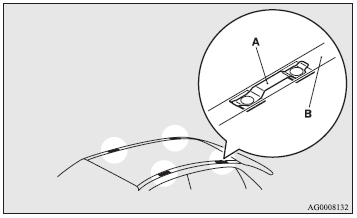 Mitsubishi Outlander: Cargo loads
Mitsubishi Outlander: Cargo loads
Cargo loads precautions
CAUTION:
● Do not load cargo or luggage higher than the top of the seatback. Be sure that
your cargo or luggage cannot move once your vehicle is moving. Having the rear view
blocked, and your cargo being thrown inside the cabin if you suddenly have to brake
can cause a serious accident or injury.
● Load heavy cargo or luggage in the front of the vehicle. If the load in the back
of the vehicle is too heavy, steering may become unstable.
Loading a roof carrier*
CAUTION:
● Use a roof carrier that properly fits your vehicle. Do not load luggage directly
onto the roof. For installation, refer to the instruction manual accompanying the
roof carrier.
NOTE:
● We recommend you to use a genuine MITSUBISHI roof carrier, since the brackets
to be used have a special shape. For details, we recommend you to consult a MITSUBISHI
MOTORS Authorised Service Point.
Roof carrier mounting brackets

When installing the roof carrier, use the brackets (A). The brackets (A) are located under each roof drip moulding (B).
Roof carrier precaution
CAUTION:
● Make sure that the weight of the luggage does not exceed the allowable roof load.
If the allowable roof load is exceeded, this may cause damage to the vehicle. The
roof load is the total allowable load on the roof (the weight of the roof carrier
plus the weight of luggage placed on the roof carrier). For the specific value,
refer to “Maximum roof load” on page 9-6.
● When luggage is loaded onto the vehicle, please make sure to drive slowly and
avoid excessive maneuvers such as sudden braking or quick turning. In addition,
place the luggage on the carrier so that its weight is distributed evenly with the
heaviest items on the bottom. Do not load items that are wider than the roof carrier.
The additional weight on the roof could raise the vehicle’s centre of gravity and
affect vehicle handling characteristics. As a result, driving errors or emergency
maneuvers could lead to a loss of control and result in an accident.
● Before driving and after travelling a short distance, always check the load to
make sure it is securely fastened to the roof carrier. Check periodically during
your travel that the load remains secure.
NOTE:
● To prevent wind noise or reduction in fuel economy, remove the roof carrier when
not in use.
● Remove the roof carrier before using an automatic car wash.
● Be sure that adequate clearance is maintained for raising the sunroof (if so equipped)
and/or the tailgate when installing a roof carrier.
 Reversing sensor system*
Reversing sensor system*
This system operates when you are backing the vehicle. It uses corner and back
sensors to detect an obstacle and sounds a buzzer to inform you of the approximate
distance to the obstacle.
CAUTION ...
 Trailer towing
Trailer towing
In order to tow a trailer with your vehicle, have a trailer towing device that
meets all relevant regulations in your area, mounted at an authorised MITSUBISHI
dealer. The regulations concerning t ...
See also:
Heated Seats — If Equipped
On some models, the front driver and passenger seats
may be equipped with heaters in both the seat cushions
and seatbacks.
There are two heated seat switches that allow the driver
and passenger ...
Replacement Keys
NOTE: Only keys that are programmed to the vehicle
electronics can be used to start and operate the vehicle.
Once a Sentry Key is programmed to a vehicle, it cannot
be programmed to any other veh ...
Disarming the system
To disarm the system, briefly press the
“” button on
the transmitter. ...
